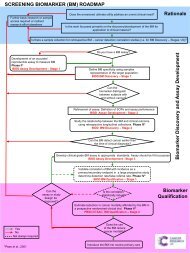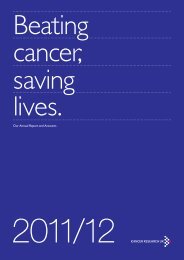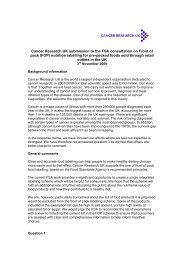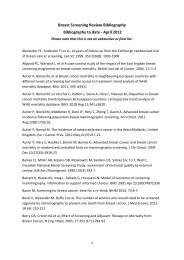Merseyside & Cheshire Cancer Network Dashboard
Merseyside & Cheshire Cancer Network Dashboard
Merseyside & Cheshire Cancer Network Dashboard
You also want an ePaper? Increase the reach of your titles
YUMPU automatically turns print PDFs into web optimized ePapers that Google loves.
<strong>Merseyside</strong> & <strong>Cheshire</strong><br />
<strong>Cancer</strong> <strong>Network</strong><br />
<strong>Dashboard</strong><br />
May 2010.<br />
If you wish to know more about the <strong>Cancer</strong> <strong>Network</strong> <strong>Dashboard</strong> please contact the <strong>Merseyside</strong><br />
and <strong>Cheshire</strong> <strong>Cancer</strong> <strong>Network</strong>.<br />
Version2.0 Part 2 <strong>Cancer</strong> <strong>Dashboard</strong> MCCN 2010
Background<br />
The National Awareness and Early Detection Initiative-NAEDI- was announced in the <strong>Cancer</strong><br />
Reform Strategy (CRS) and is being led by Professor Mike Richards, National <strong>Cancer</strong> Director<br />
and Harpel Kumar the Chief Executive of <strong>Cancer</strong> Research UK. <strong>Cancer</strong> <strong>Network</strong>s are well placed<br />
to provide leadership for prevention and early diagnosis. <strong>Cancer</strong> <strong>Network</strong>s and PCTs are<br />
expected to undertake a baseline assessment that will inform <strong>Network</strong> and PCT Strategic<br />
Commissioning Plans to ensure effective progress in this area based on local needs.<br />
A <strong>Cancer</strong> <strong>Dashboard</strong><br />
The cancer network have developed performance measures that include baseline measures but<br />
also add further quality to information that is appropriate for PCTs and GP practices and we want<br />
to embed these into a more robust cancer dashboard using and testing measures. We see this as<br />
a way of assessing current baselines within PCTs and also practices but will also enable us to<br />
analyse performance regularly.<br />
The cancer dashboard will be outcome driven; each PCT will be asked to complete a template<br />
with the Early Detection and Awareness Strategy lead team. We will agree milestones with PCTs<br />
and assist them in supporting the gathering of evidence for the individual measures, including<br />
measures by practice. We envisage that action plans will be developed and adopted by PCT<br />
boards as appropriate and recommendations will be made to commissioners, these<br />
recommendations will be more likely to be considered as they will be evidence based. A key<br />
element of the cancer dashboard will be the development of a database that PCTs and practices<br />
can access to review performance and to create reports.<br />
The cancer dashboard will:<br />
<br />
<br />
<br />
<br />
<br />
<br />
Collate primary care equity audits for urgent referrals in the PCT by practice- this will<br />
include, review of referring patterns linked to deprivation, number of referrals, cancer<br />
yield. This is different than the primary care audits.<br />
Capture data within templates for survival, mortality, incidence, screening and staging<br />
data and will identify key trends and variations.<br />
Provide PCT reporting in a template that will demonstrate compliance with national and<br />
local baseline assessments identified within the <strong>Cancer</strong> Reform Strategy.<br />
Provide information about screening performance at GP practice and PCT level,<br />
templates for GP practices will be made available.<br />
Capture action plans to enable Commissioners to make decisions on services.<br />
Test other performance measures around commissioning such as length of stay analysis<br />
and other commissioning priorities.<br />
We believe that the cancer dashboard will enhance the PCTs ability to demonstrate their<br />
progress on world class commissioning (WCC) and quality, innovation, productivity and<br />
prevention (QUIPP)<br />
Dr Daniel Seddon- Early detection and prevention lead<br />
Paul Mackenzie- Health Inequalities Manager<br />
Version 2 <strong>Cancer</strong> <strong>Dashboard</strong> MCCN 2010 2
Baseline key metrics and indicators for the <strong>Cancer</strong> <strong>Dashboard</strong>.<br />
No Performance category <strong>Network</strong> PCT Practice Trust<br />
1. Proportion of diagnosed cancers reaching a 90% registration status (including staging) with<br />
√ √ √<br />
NWCIS after 90 days<br />
2. TWW activity including did not attend (DNA) and cancellation rates √ √ √ √<br />
3. Total number of Urgent 2 week wait referrals by tumour site √ √ √ √<br />
4. Urgent 2 week wait cancer referral yield rate by tumour site (Yield = No of Diagnosis <strong>Cancer</strong>s/<br />
√ √ √<br />
Number of Urgent 2 week wait referrals<br />
5. Number of Urgent 2 week wait cancer referrals by tumour site with a cancer diagnosis √<br />
6. Coverage rates for national bowel cancer screening programme √ √<br />
7. % variation from national coverage rates for bowel cancer screening programme √ √<br />
8. Number of cancers detected as a result of the bowel cancer screening programme √ √<br />
9. % Never screened for bowel cancer √ √<br />
10. Coverage rates for national cervical screening programme √ √<br />
11. % variation from national coverage rates for the cervical screening programme √ √<br />
12. Number of cancers detected as a result of the cervical screening programme √ √<br />
13. % Never screened for cervical cancer √ √<br />
14. % patients receiving cervical screening results within 2 weeks following screening √<br />
15. Lab data<br />
16. Coverage rates for national breast screening programme √ √<br />
17. % variation from national coverage rates for the breast screening programme √ √<br />
18. Number of cancers detected as a result of the breast screening programme √ √<br />
19. % Never screened for breast cancer √ √<br />
20. European Age Standardised <strong>Cancer</strong> Incidence rates for all cancers compared to the national<br />
√<br />
√<br />
average and best in Europe (if appropriate)<br />
21. European Age Standardised <strong>Cancer</strong> Mortality rates for all cancers compared to the national<br />
√<br />
√<br />
average and best in Europe (if appropriate)<br />
22. % variation in 1 year relative survival rates for all cancers compared to the national average and √<br />
best in Europe (if appropriate)<br />
23. % variation in 5 year relative survival rates for all cancers compared to the national average and √<br />
best in Europe (if appropriate)<br />
24. Number of emergency admissions resulting in the first definitive cancer diagnosis √ √ √
1. Public awareness of <strong>Cancer</strong><br />
The <strong>Cancer</strong> Awareness Measure has been developed as part of the national awareness and<br />
early detection initiative (NAEDI) to help to ensure the delivery of the <strong>Cancer</strong> Reform Strategy<br />
(CRS). The survey has been designed to benchmark the current level of awareness amongst the<br />
population. The CAM will serve as a baseline against which we will be able to evaluate<br />
awareness raising initiatives within PCTs.<br />
The CAM is usually a face to face interview or telephone interview<br />
Awareness of cancer signs and symptoms<br />
Help-seeking behaviour<br />
Awareness of risk factors<br />
Awareness of cancer incidence and common cancers<br />
Awareness of cancer screening programmes<br />
Contribution to cancer<br />
<strong>Cancer</strong> Awareness Measure<br />
1a<br />
Has the PCT conducted a CAM to benchmark local awareness?<br />
Level 1 PCT not aware of the level of knowledge in the local population<br />
Level 2 Plans being developed for 2010/11<br />
Level 3 Some evidence of awareness measurement<br />
Level 4 The PCT can demonstrate baseline measurement of public knowledge of cancer<br />
Level 5<br />
Excellent<br />
CAM measure or equivalent conducted in the PCT. Further evidence of<br />
application to specific groups in society demonstrated.<br />
Self<br />
Evidence summary:<br />
assessment<br />
rating
Public awareness<br />
1b<br />
Has the PCT engaged the public in cancer awareness activity?<br />
Level 1 PCT cannot identify any cancer awareness initiatives in the PCT<br />
Level 2 Plans being developed for 2010/11<br />
Level 3 Some evidence of cancer awareness activity in one or two cancer specific areas<br />
Level 4 The PCT can demonstrate strong community engagement with examples of<br />
cancer awareness activity<br />
Level 5 The PCT has targeted cancer awareness campaigns or activity and is actively<br />
Excellent engaged in developing knowledge and understanding in communities. (e.g.<br />
Health Communities <strong>Cancer</strong> Collaborative) There are plans to repeat the CAM to<br />
Self<br />
assessment<br />
rating<br />
evaluate increased awareness.<br />
Evidence summary:<br />
Local action plan<br />
How will the PCT identify cancer awareness knowledge in the population and what awareness<br />
campaigns will be targeted?<br />
Action to be taken<br />
Who will lead on the delivery of this action?<br />
Identify milestones<br />
Version 2 <strong>Cancer</strong> <strong>Dashboard</strong> MCCN 2010 5
2. Screening<br />
a. Bowel<br />
b. Breast<br />
c. Cervical<br />
Bowel cancer screening<br />
Roll out of the national bowel cancer screening programme has been achieved within <strong>Cheshire</strong><br />
and <strong>Merseyside</strong>. This programme invites most men and women aged 60-69 years. Self referral<br />
was an option during the first phase of roll out. The CRS (2009) second annual report highlights<br />
that 4.5 million kits have been sent out resulting in 17,000 polyp removals and 4,000 cancers<br />
being diagnosed.<br />
The extension of bowel screening to men and women aged 70-75 from 2010 is a Vital Sign in the<br />
NHS Operating Framework (VSA10).<br />
There is currently no national target for bowel screening although pilot studies resulted in around<br />
a 60% coverage rate. There is considerable variation of uptake amongst those in lower socio<br />
economic areas, within different ethnicity and cultures and in those who are no registered with a<br />
GP.<br />
Breast screening<br />
The NHS Breast Screening Programme provides free breast screening every three years for all<br />
women in the UK aged 50 and over. Around one-and-a-half million women are screened in the<br />
UK each year. Women aged between 50 and 70 are now routinely invited.<br />
The NHS Breast Screening Programme will extend the age range of women eligible for breast<br />
screening to ages 47 to 73 by 2012.<br />
The national target for breast screening coverage is 70%.<br />
Cervical screening<br />
All women between the ages of 25 and 64 are eligible for a free cervical screening test every<br />
three to five years. The NHS Cervical Screening Programme now offers screening at different<br />
intervals depending on age. This means that women are provided with a more targeted and<br />
effective screening programme. The national coverage rate is 80%<br />
The new intervals are;<br />
Age Duration<br />
25 First invitation<br />
25 - 49 3 yearly<br />
50 - 64 5 yearly<br />
65+ Only screen those who have not been screened since age 50 or have had recent<br />
abnormal tests<br />
Achieving a 14 day turnaround time for results of cervical screening is a Vital Sign in the NHS<br />
Operating Framework (VSA15). This is to be achieved by the end of 2010.<br />
Version 2 <strong>Cancer</strong> <strong>Dashboard</strong> MCCN 2010 6
Operational leadership<br />
2a<br />
Does the PCT have a screening operational and strategic lead in place?<br />
Level 1 The PCT does not have an operational screening lead in place<br />
Level 2 The PCT designates this responsibility to a number of people<br />
Level 3 The PCT has an operational and strategic lead<br />
Level 4 The PCT has an operational and strategic lead and they represent the PCT at a<br />
variety of screening meetings<br />
Level 5<br />
Excellent<br />
The PCT has an operational and strategic lead and they represent the PCT at a<br />
variety of screening meetings. They are actively engaged in the cancer network<br />
Self<br />
assessment<br />
rating<br />
and public health network screening groups<br />
Evidence summary:<br />
Implementation plans<br />
2b<br />
Does the PCT have an implementation plan for screening in place?<br />
Level 1 No plan in place<br />
Level 2 Plans being developed<br />
Level 3 An operational plan is only available for some of the screening programmes<br />
Level 4 A full operational plan is in place and can be shared for all cancer screening<br />
programmes<br />
Level 5<br />
Excellent<br />
A full operational plan is in place and can be shared for all cancer screening<br />
programmes. Action plans and performance is reviewed regularly and shared<br />
Self<br />
assessment<br />
rating<br />
with the PCT board.<br />
Evidence summary:<br />
Version 2 <strong>Cancer</strong> <strong>Dashboard</strong> MCCN 2010 7
Breast screening extension<br />
2c<br />
Has the PCT made plans to start the extension of breast cancer screening<br />
offered to women aged 47-49 and 71-73 from April 2010?<br />
Level 1 No plans in place<br />
Level 2 Plans in place<br />
Level 3 Making good progress on plans<br />
Level 4 Breast extension will begin after April 2010<br />
Level 5 Breast extension has begun<br />
Excellent<br />
Self<br />
assessment<br />
rating<br />
Two week reporting cervical screening<br />
2d<br />
Is the PCT reporting the results of cervical screening within two weeks?<br />
Level 1 No plans in place<br />
Level 2 Not able to review data<br />
Level 3 Data reviewed but performance is below expectations 80%<br />
Level 4 90% of 2 week turnaround<br />
Level 5 99% of 2 week turnaround<br />
Excellent<br />
Self<br />
assessment<br />
rating<br />
Bowel cancer screening coverage<br />
2e<br />
How is the PCT achieving the national average coverage rate for bowel<br />
screening? How is the PCT improving coverage rates<br />
Level 1 The PCT overall is not achieving level 2<br />
Level 2 The PCT overall is achieving between at least 50% and 54% coverage with more<br />
than a third of ward areas having more than 50%<br />
Level 3 The PCT overall is achieving between 55% and 59% coverage with more than<br />
two thirds of ward areas having more than 55%<br />
Level 4 The PCT overall is achieving between 60% and 64% coverage with more than<br />
two thirds of ward areas having more than 60%<br />
Level 5 The PCT overall is achieving between 65 and 69% coverage with more than two<br />
Excellent thirds of ward areas having more than 65%<br />
Self<br />
How is the PCT improving screening rates?<br />
assessment<br />
rating<br />
Version 2 <strong>Cancer</strong> <strong>Dashboard</strong> MCCN 2010 8
Breast cancer screening coverage<br />
2f<br />
How is the PCT achieving the national average coverage rate breast screening?<br />
How is the PCT improving coverage rates<br />
Level 1 The PCT is not achieving level 2<br />
Level 2 The PCT overall is achieving between 50% and 54% coverage with more than<br />
two thirds of practices having more than 50%<br />
Level 3 The PCT overall is achieving between 60% and 64% coverage with more than<br />
two thirds practices having more than 60%<br />
Level 4 The PCT overall is achieving between 65% and 69% coverage with more than<br />
two thirds of practices having more than 65%<br />
Level 5 All practices in the PCT are achieving 70% coverage or more<br />
Excellent<br />
Self<br />
How is the PCT improving screening rates?<br />
assessment<br />
rating<br />
Cervical screening coverage<br />
2g<br />
How is the PCT achieving the national average coverage rate for cervical<br />
screening? How is the PCT improving coverage rates<br />
Level 1 The PCT is not achieving level 2<br />
Level 2 The PCT overall is achieving between 65% and 69% coverage with more than<br />
two thirds of practices having more than 65%<br />
Level 3 The PCT overall is achieving between 70% and 74% coverage with more than<br />
two thirds of practices having more than 70%<br />
Level 4 The PCT overall is achieving between 75% and 79% coverage with more than<br />
two thirds of practices having more than 75%<br />
Level 5 All practices in the PCT are achieving more than 80% coverage or more<br />
Excellent<br />
Self<br />
assessment<br />
rating<br />
Version 2 <strong>Cancer</strong> <strong>Dashboard</strong> MCCN 2010 9
Non participants in screening<br />
2h<br />
How is the PCT identifying which groups in the community are not participating<br />
in screening?<br />
Level 1 The PCT cannot identify the groups<br />
Level 2 The PCT is aware of the different groups who are not taking up screening<br />
Level 3 The PCT identify groups and individuals who do not take up screening<br />
Level 4 The PCT has a system in place to ensure all groups are invited for screening<br />
Level 5 The PCT has a system in place to ensure all groups are invited for screening<br />
Excellent and can demonstrate performance<br />
Self<br />
assessment<br />
rating<br />
How will the PCT improve coverage rates for screening?<br />
Action to be taken<br />
Bowel cancer screening<br />
Breast screening<br />
Cervical screening<br />
Who will lead on the delivery of this action?<br />
Identify milestones<br />
Version 2 <strong>Cancer</strong> <strong>Dashboard</strong> MCCN 2010 10
3. Delays in presentation/ Referral<br />
Patient’s survival and mortality is likely to be poorer if they present late to primary care with<br />
potential cancer symptoms. Community engagement projects such as the Healthy Communities<br />
Collaborative and IVAN mobile support and information service can target awareness and prompt<br />
earlier presentation to primary care.<br />
The national audit of cancer diagnosis in primary care is a tool supported by the Royal College of<br />
General Practitioners and the National <strong>Cancer</strong> Action Team. The tool captures themes in the<br />
patient experience from delay presenting to the GP, through referral and diagnostics. This tool is<br />
a reflective learning tool; each practice reviews the pathway for each audit. Yearly audits like this<br />
have been highlighted as a key recommendation from the All Party Parliamentary Group on<br />
<strong>Cancer</strong>.<br />
Primary care audits<br />
3a<br />
The PCT can provide evidence of audits that inform the PCT of delays in the<br />
patient experience prior to diagnosis using primary care audits<br />
Level 1 No evidence<br />
Level 2 Plans to participate in audits<br />
Level 3 PCT has been involved in network primary care audit initiative<br />
Level 4 The PCT plans involve at least a third of all practices in collecting audits<br />
Level 5 The PCT has developed an agreement to repeat audits in each practice yearly<br />
Excellent<br />
Self<br />
assessment<br />
rating<br />
Referral under the urgent two week waits (TWW)<br />
3b<br />
The PCT regularly reviews urgent TWW activity including did not attend (DNA)<br />
and cancellation rates<br />
Level 1 The PCT is not at level 2<br />
Level 2 The PCT can demonstrate that it is starting to review TWW data on DNA/<br />
cancellation rates<br />
Level 3 The PCT can extract reports by GP practice to show DNA cancellation rates<br />
Level 4 The PCT can extract reports by GP practice to show DNA cancellation rates and<br />
reviews them at cancer action team meetings. A plan has been developed to<br />
reduce DNA/ cancellation rates. The PCT can demonstrate a reduction in DNA/<br />
Cancellation rates by PCT<br />
Level 5<br />
Excellent<br />
Self<br />
assessment<br />
rating<br />
The PCT can extract reports by GP practice to show DNA cancellation rates and<br />
reviews them at cancer action team meetings. A plan has been developed to<br />
reduce DNA/ cancellation rates. The PCT can demonstrate a reduction in DNA/<br />
Cancellation rates by PCT and by those practice with the worst DNA rates<br />
Version 2 <strong>Cancer</strong> <strong>Dashboard</strong> MCCN 2010 11
3c<br />
Level 1<br />
Level 2<br />
Level 3<br />
Level 4<br />
Level 5<br />
Excellent<br />
The PCT regularly reviews TWW activity including yield rates<br />
Does not review urgent rates by practice<br />
Reviews TWW on a ad hoc basis<br />
Reviews TWW and reports findings to PCT<br />
Reviews TWW and provides regular reports on efficiency including yield rates<br />
Reviews TWW data every quarter and reports on efficiency to PCT, GP and<br />
Trust colleagues. Initiatives to improve TWW. <strong>Cancer</strong> yield rates can be<br />
identified (referrals versus actual cancer diagnosis). Equity audits have been<br />
completed for the PCT<br />
Emergency presentation<br />
3d<br />
The PCT can review cancers that have been diagnosed via accident and<br />
emergency<br />
Level 1 Unable to identify cancers via this route<br />
Level 2 PCT is exploring ways to gather this data<br />
Level 3 PCTs can identify emergency presentations resulting in a cancer diagnosis<br />
Level 4 PCTs can identify emergency presentations resulting in a cancer diagnosis and<br />
this is shared with GP practices<br />
Level 5<br />
Excellent<br />
Self<br />
assessment<br />
rating<br />
PCTs can identify emergency presentations resulting in a cancer diagnosis and<br />
this is shared with GP practices. The reasons for emergency presentation are<br />
being investigated and performance can be measured on a regular basis<br />
How will the PCT improve referrals?<br />
Action to be taken<br />
Who will lead on the delivery of this action?<br />
Identify milestones<br />
Version 2 <strong>Cancer</strong> <strong>Dashboard</strong> MCCN 2010 12
4. Staging<br />
The information for the stage of cancer is essential to help a person choose the best treatment. It<br />
also helps them to understand their prognosis.<br />
<strong>Cancer</strong> Registration<br />
4a<br />
Level 1<br />
Level 2<br />
Level 3<br />
Level 4<br />
Level 5<br />
Excellent<br />
Self<br />
assessment<br />
rating<br />
Bladder<br />
How complete is the clinical stage data for cancers 3 months after registration?<br />
Less than 50% and has a system in place to capture staging data (i.e. Somerset)<br />
50%-59% and has a system in place to capture staging data (i.e. Somerset)<br />
60%-79% and has a system in place to capture staging data (i.e. Somerset)<br />
80%-89% and has a system in place to capture staging data (i.e. Somerset) and<br />
regularly review staging data<br />
90+% and has a system in place to capture staging data (i.e. Somerset) and<br />
regularly review staging data in collaboration with the cancer network and<br />
NWCIS<br />
Evidence summary:<br />
4b<br />
Level 1<br />
Level 2<br />
Level 3<br />
Level 4<br />
Level 5<br />
Excellent<br />
Self<br />
assessment<br />
rating<br />
Bladder<br />
How complete is the final stage data for cancers 3 months after registration?<br />
Less than 50% and has a system in place to capture staging data (i.e. Somerset)<br />
50%-59% and has a system in place to capture staging data (i.e. Somerset)<br />
60%-79% and has a system in place to capture staging data (i.e. Somerset)<br />
80%-89% and has a system in place to capture staging data (i.e. Somerset) and<br />
regularly review staging data<br />
90+% and has a system in place to capture staging data (i.e. Somerset) and<br />
regularly review staging data in collaboration with the cancer network and<br />
NWCIS<br />
Evidence summary:<br />
Version 2 <strong>Cancer</strong> <strong>Dashboard</strong> MCCN 2010 13
4c<br />
Level 1<br />
Level 2<br />
Level 3<br />
Level 4<br />
Level 5<br />
Excellent<br />
Self<br />
assessment<br />
rating<br />
Prostate<br />
How complete is the clinical stage for cancers 3 months after registration?<br />
Less than 50% and has a system in place to capture staging data (i.e. Somerset)<br />
50%-59% and has a system in place to capture staging data (i.e. Somerset)<br />
60%-79% and has a system in place to capture staging data (i.e. Somerset)<br />
80%-89% and has a system in place to capture staging data (i.e. Somerset) and<br />
regularly review staging data<br />
90+% and has a system in place to capture staging data (i.e. Somerset) and<br />
regularly review staging data in collaboration with the cancer network and<br />
NWCIS<br />
Evidence summary:<br />
4d<br />
Level 1<br />
Level 2<br />
Level 3<br />
Level 4<br />
Level 5<br />
Excellent<br />
Self<br />
assessment<br />
rating<br />
Prostate<br />
How complete is the final stage data for cancers 3 months after registration?<br />
Less than 50% and has a system in place to capture staging data (i.e. Somerset)<br />
50%-59% and has a system in place to capture staging data (i.e. Somerset)<br />
60%-79% and has a system in place to capture staging data (i.e. Somerset)<br />
80%-89% and has a system in place to capture staging data (i.e. Somerset) and<br />
regularly review staging data<br />
90+% and has a system in place to capture staging data (i.e. Somerset) and<br />
regularly review staging data in collaboration with the cancer network and<br />
NWCIS<br />
Evidence summary:<br />
4e<br />
Level 1<br />
Level 2<br />
Level 3<br />
Level 4<br />
Level 5<br />
Excellent<br />
Self<br />
assessment<br />
rating<br />
Colorectal<br />
How complete is the clinical stage for cancers 3 months after registration?<br />
Less than 50% and has a system in place to capture staging data (i.e. Somerset)<br />
50%-59% and has a system in place to capture staging data (i.e. Somerset)<br />
60%-79% and has a system in place to capture staging data (i.e. Somerset)<br />
80%-89% and has a system in place to capture staging data (i.e. Somerset) and<br />
regularly review staging data<br />
90+% and has a system in place to capture staging data (i.e. Somerset) and<br />
regularly review staging data in collaboration with the cancer network and<br />
NWCIS<br />
Evidence summary:<br />
Version 2 <strong>Cancer</strong> <strong>Dashboard</strong> MCCN 2010 14
4f<br />
Level 1<br />
Level 2<br />
Level 3<br />
Level 4<br />
Level 5<br />
Excellent<br />
Self<br />
assessment<br />
rating<br />
Colorectal<br />
How complete is the final stage data for cancers 3 months after registration?<br />
Less than 50% and has a system in place to capture staging data (i.e. Somerset)<br />
50%-59% and has a system in place to capture staging data (i.e. Somerset)<br />
60%-79% and has a system in place to capture staging data (i.e. Somerset)<br />
80%-89% and has a system in place to capture staging data (i.e. Somerset) and<br />
regularly review staging data<br />
90+% and has a system in place to capture staging data (i.e. Somerset) and<br />
regularly review staging data in collaboration with the cancer network and<br />
NWCIS<br />
Evidence summary:<br />
4g<br />
Level 1<br />
Level 2<br />
Level 3<br />
Level 4<br />
Level 5<br />
Excellent<br />
Self<br />
assessment<br />
rating<br />
Malignant Melanoma<br />
How complete is the final stage data for cancers 3 months after registration?<br />
Less than 50% and has a system in place to capture staging data (i.e. Somerset)<br />
50%-59% and has a system in place to capture staging data (i.e. Somerset)<br />
60%-79% and has a system in place to capture staging data (i.e. Somerset)<br />
80%-89% and has a system in place to capture staging data (i.e. Somerset) and<br />
regularly review staging data<br />
90+% and has a system in place to capture staging data (i.e. Somerset) and<br />
regularly review staging data in collaboration with the cancer network and<br />
NWCIS<br />
Evidence summary:<br />
4h<br />
Level 1<br />
Level 2<br />
Level 3<br />
Level 4<br />
Level 5<br />
Excellent<br />
Self<br />
assessment<br />
rating<br />
Lung<br />
How complete is the clinical stage for cancers 3 months after registration?<br />
Less than 50% and has a system in place to capture staging data (i.e. Somerset)<br />
50%-59% and has a system in place to capture staging data (i.e. Somerset)<br />
60%-79% and has a system in place to capture staging data (i.e. Somerset)<br />
80%-89% and has a system in place to capture staging data (i.e. Somerset) and<br />
regularly review staging data<br />
90+% and has a system in place to capture staging data (i.e. Somerset) and<br />
regularly review staging data in collaboration with the cancer network and<br />
NWCIS<br />
Evidence summary:<br />
Version 2 <strong>Cancer</strong> <strong>Dashboard</strong> MCCN 2010 15
4i<br />
Level 1<br />
Level 2<br />
Level 3<br />
Level 4<br />
Level 5<br />
Excellent<br />
Self<br />
assessment<br />
rating<br />
Lung<br />
How complete is the final stage data for cancers 3 months after registration?<br />
Less than 50% and has a system in place to capture staging data (i.e. Somerset)<br />
50%-59% and has a system in place to capture staging data (i.e. Somerset)<br />
60%-79% and has a system in place to capture staging data (i.e. Somerset)<br />
80%-89% and has a system in place to capture staging data (i.e. Somerset) and<br />
regularly review staging data<br />
90+% and has a system in place to capture staging data (i.e. Somerset) and<br />
regularly review staging data in collaboration with the cancer network and<br />
NWCIS<br />
Evidence summary:<br />
4j<br />
Level 1<br />
Level 2<br />
Level 3<br />
Level 4<br />
Level 5<br />
Excellent<br />
Self<br />
assessment<br />
rating<br />
Breast<br />
How complete is the clinical stage for cancers 3 months after registration?<br />
Less than 50% and has a system in place to capture staging data (i.e. Somerset)<br />
50%-59% and has a system in place to capture staging data (i.e. Somerset)<br />
60%-79% and has a system in place to capture staging data (i.e. Somerset)<br />
80%-89% and has a system in place to capture staging data (i.e. Somerset) and<br />
regularly review staging data<br />
90+% and has a system in place to capture staging data (i.e. Somerset) and<br />
regularly review staging data in collaboration with the cancer network and<br />
NWCIS<br />
Evidence summary:<br />
4k<br />
Level 1<br />
Level 2<br />
Level 3<br />
Level 4<br />
Level 5<br />
Excellent<br />
Self<br />
assessment<br />
rating<br />
Breast<br />
How complete is the final stage data for cancers 3 months after registration?<br />
Less than 50% and has a system in place to capture staging data (i.e. Somerset)<br />
50%-59% and has a system in place to capture staging data (i.e. Somerset)<br />
60%-79% and has a system in place to capture staging data (i.e. Somerset)<br />
80%-89% and has a system in place to capture staging data (i.e. Somerset) and<br />
regularly review staging data<br />
90+% and has a system in place to capture staging data (i.e. Somerset) and<br />
regularly review staging data in collaboration with the cancer network and<br />
NWCIS<br />
Evidence summary:<br />
Version 2 <strong>Cancer</strong> <strong>Dashboard</strong> MCCN 2010 16
4l<br />
Level 1<br />
Level 2<br />
Level 3<br />
Level 4<br />
Level 5<br />
Excellent<br />
Self<br />
assessment<br />
rating<br />
Haematology – Hodgkin lymphoma<br />
How complete is the final stage data for cancers 3 months after registration?<br />
Less than 50% and has a system in place to capture staging data (i.e. Somerset)<br />
50%-59% and has a system in place to capture staging data (i.e. Somerset)<br />
60%-79% and has a system in place to capture staging data (i.e. Somerset)<br />
80%-89% and has a system in place to capture staging data (i.e. Somerset) and<br />
regularly review staging data<br />
90+% and has a system in place to capture staging data (i.e. Somerset) and<br />
regularly review staging data in collaboration with the cancer network and<br />
NWCIS<br />
Evidence summary:<br />
MDT performance<br />
4m<br />
Is MDT performance improving?<br />
Level 1 No MDT data submitted<br />
Level 2 MDT data being submitted<br />
Level 3 MDT data submitted for all MDTs<br />
Level 4 MDT data submitted for all MDTs and the quality is reviewed. MDTs have self<br />
assessed themselves. Annual audits can be demonstrated. Data captured for<br />
ethnicity, gender, age and treatment on Somerset <strong>Cancer</strong> Register or MDT<br />
proforma.<br />
Level 5 MDT data submitted for all MDTs and the quality is reviewed. With 90% of data<br />
Excellent sets completed. MDTs have self assessed themselves. MDT completes annual<br />
audits and can demonstrate that it can capture stage, ethnicity, gender, age and<br />
Self<br />
assessment<br />
rating<br />
treatment<br />
Evidence summary:<br />
How will the PCT improve MDTs?<br />
Action to be taken<br />
Who will lead on the delivery of this action?<br />
Identify milestones<br />
Version 2 <strong>Cancer</strong> <strong>Dashboard</strong> MCCN 2010 17
5. <strong>Cancer</strong> incidence, cancer mortality<br />
<strong>Cancer</strong> incidence<br />
5a<br />
Does the PCT review cancer incidence?<br />
Level 1 The PCT has not completed baseline cancer incidence data<br />
Level 2 Some evidence of recording cancer incidence emerging, but not for all the main<br />
cancers<br />
Level 3 <strong>Cancer</strong> incidence completed for all the main cancers. National and international<br />
benchmarks completed<br />
Level 4 <strong>Cancer</strong> incidence completed for all the main cancers. National and international<br />
benchmarks completed The PCT has reviewed the cancers where the incidence<br />
is increasing the most.<br />
Level 5<br />
Excellent<br />
Self<br />
assessment<br />
rating<br />
<strong>Cancer</strong> incidence completed for all the main cancers. National and international<br />
benchmarks completed The PCT has reviewed the cancers where the incidence<br />
is increasing the fastest. The PCT analyses cancer incidence rates versus other<br />
factors such as survival and mortality.<br />
<strong>Cancer</strong> mortality<br />
5b<br />
Does the PCT review cancer mortality?<br />
Level 1 The PCT has not completed baseline cancer mortality data<br />
Level 2 Some evidence of recording cancer mortality emerging, but not for all the main<br />
cancers, bowel, lung, breast and prostate<br />
Level 3 <strong>Cancer</strong> mortality completed for all the main cancers. National and international<br />
benchmarks completed. PCT ambitious cancer mortality has been set.<br />
Level 4 <strong>Cancer</strong> mortality completed for all the main cancers. National and international<br />
benchmarks completed. PCT ambitious cancer mortality has been set. The PCT<br />
has reviewed the cancers where the cancer mortality is the highest.<br />
Level 5<br />
Excellent<br />
Self<br />
assessment<br />
rating<br />
<strong>Cancer</strong> mortality completed for all the main cancers. National and international<br />
benchmarks completed. PCT ambitious cancer mortality has been set. The PCT<br />
has reviewed the cancers where the cancer mortality is the highest. Mortality<br />
rates have been scoped for the over 75s<br />
Version 2 <strong>Cancer</strong> <strong>Dashboard</strong> MCCN 2010 18
How will the PCT reduce cancer mortality?<br />
Action to be taken<br />
Who will lead on the delivery of this action?<br />
Identify milestones<br />
6. Survival<br />
<strong>Cancer</strong> Survival<br />
6a<br />
Does the PCT review survival data?<br />
Level 1 No evidence<br />
Level 2 PCT receives regular survival reports for 5 year survival<br />
Level 3 PCT receives regular survival reports for 5 year survival and analyses data<br />
Level 4 PCT analyses some data and collects 1 and 5 year data. The PCT is involved in<br />
1 and 5 year survival discussions network wide for less common cancer types<br />
Level 5<br />
Excellent<br />
Self<br />
assessment<br />
rating<br />
PCT uses data to analyse survival for all cancer. Collects 1 and 5 year survival<br />
rates and compares results against international benchmarks. The PCT<br />
understands 1 and 5 year survival data for less common cancer types<br />
How will the PCT improve cancer survival?<br />
Action to be taken<br />
Who will lead on the delivery of this action?<br />
Identify milestones<br />
Version 2 <strong>Cancer</strong> <strong>Dashboard</strong> MCCN 2010 19
7. Inequalities<br />
<strong>Cancer</strong> Inequalities<br />
7a<br />
Can the PCT identify specific groups where the cancer inequalities are the<br />
greatest?<br />
Level 1 No evidence<br />
Level 2 The PCT can identify specific groups were inequalities are the greatest<br />
Level 3 The PCT can provide data that shows inequalities for marginalized groups in<br />
respect of cancer mortality, incidence and screening activity<br />
Level 4 The PCT can provide data that shows inequalities for marginalized groups in<br />
respect of cancer mortality, incidence and screening activity. Data intelligence<br />
can be shared on groups described in the national cancer equality initiative. BME<br />
communities, those with disabilities, age related inequalities, young people,<br />
socio economic inequalities, people who are disadvantaged because of sexual<br />
orientation<br />
Level 5<br />
Excellent<br />
Self<br />
assessment<br />
rating<br />
The PCT can provide data that shows inequalities for marginalized groups in<br />
respect of cancer mortality, incidence and screening activity. Data intelligence<br />
can be shared on groups described in the national cancer equality initiative. BME<br />
communities, those with disabilities, age related inequalities, young people,<br />
socio economic inequalities, people who are disadvantaged because of sexual<br />
orientation. The PCT demonstrates interventions and outcomes to reduce<br />
inequalities.<br />
How will the PCT reduce cancer inequalities?<br />
Action to be taken<br />
Who will lead on the delivery of this action?<br />
Identify milestones<br />
Version 2 <strong>Cancer</strong> <strong>Dashboard</strong> MCCN 2010 20
8. Local Plans: Findings from local awareness and early detection initiative or strategy (LAEDI)<br />
a. Summary of event<br />
b. Key recommendations<br />
Key issues discussed<br />
Action to be taken<br />
Who will lead on the delivery of this action?<br />
9. Example of local initiatives<br />
a. Community engagement<br />
b. Service improvement<br />
c. Reducing inequalities<br />
Examples of local cancer action and initiatives?<br />
Name of initiative (Describe the initiative, what was the outcome?)<br />
Name of initiative (Describe the initiative, what was the outcome?)<br />
Name of initiative (Describe the initiative, what was the outcome?)<br />
Name of initiative (Describe the initiative, what was the outcome?)<br />
Name of initiative (Describe the initiative, what was the outcome?)<br />
Version 2 <strong>Cancer</strong> <strong>Dashboard</strong> MCCN 2010 21
10. Commissioning commitments- operating plan and strategic commissioning plans<br />
Key cancer commissioning pledges<br />
Summary of key cancer priorities<br />
Other priorities identified<br />
Version 2 <strong>Cancer</strong> <strong>Dashboard</strong> MCCN 2010 22
<strong>Cancer</strong> Performance summary table for xxx PCT<br />
▲ ▲ ▲ ▲ ▲<br />
Number Measure Level1 Level2 Level 3 Level 4 Level 5<br />
1a Has the PCT conducted a CAM to benchmark local awareness? ▲<br />
1b Has the PCT engaged the public in cancer awareness activity? ▲<br />
2a Does the PCT have a screening operational and strategic lead in place? ▲<br />
2b Does the PCT have an implementation plan for screening in place? ▲<br />
2c Has the PCT made plans to start the extension of breast cancer screening offered to women ▲<br />
aged 47-49 and 71-73 from April 2010?<br />
2d Is the PCT reporting the results of cervical screening within two weeks? ▲<br />
2e How is the PCT achieving the national average coverage rate for bowel screening? How is the<br />
PCT improving coverage rates<br />
▲<br />
2f How is the PCT achieving the national average coverage rate breast screening? How is the<br />
PCT improving coverage rates<br />
▲<br />
2g How is the PCT achieving the national average coverage rate for cervical screening? How is<br />
the PCT improving coverage rates<br />
▲<br />
2h How is the PCT identifying which groups in the community are not participating in screening? ▲<br />
3a The PCT can provide evidence of audits that inform the PCT of delays in the patient<br />
experience prior to diagnosis using primary care audits<br />
▲<br />
3b The PCT regularly reviews urgent TWW activity The PCT regularly reviews urgent TWW<br />
activity including did not attend (DNA) and cancellation rates<br />
▲<br />
3c The PCT regularly reviews TWW activity including yield rates ▲<br />
3d The PCT can review cancers that have been diagnosed via accident and emergency ▲<br />
4a How complete is staging data for cancers 3 months after registration? ▲<br />
4b Is MDT performance improving? ▲<br />
5a Does the PCT review cancer incidence? ▲<br />
5b Does the PCT review cancer mortality? ▲<br />
6a Does the PCT review survival data? ▲<br />
7a Can the PCT identify specific groups where the cancer inequalities are the greatest? ▲















![[PDF] Cancer Research UK's strategy 2009 - 2014](https://img.yumpu.com/29239422/1/184x260/pdf-cancer-research-uks-strategy-2009-2014.jpg?quality=85)
